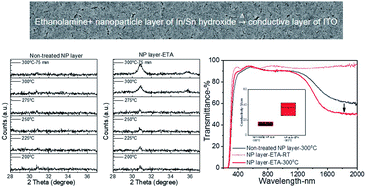Ethanolamine-assisted low-temperature crystallization of hydroxide nanoparticle ink into transparent and conductive ITO layers
Abstract
Low-temperature crystallization is desired for achieving solution processable transparent conductive oxide (TCO) layers. Here we demonstrate a low-temperature crystallization of tin doped indium oxide (ITO) layers by taking preformed indium-tin hydroxide nanoparticles as the precursor and applying surface modification with ethanolamine on the as-prepared layers. Surface modification with ethanolamine is shown to speed up the dehydration of the hydroxide precursor, resulting in earlier onset of crystallization into the cubic bixbyite ITO phase with a larger crystal size. The ethanolamine-modified ITO nanoparticle layer possesses fewer surface hydroxyl groups as compared to the non-treated layer, corresponding to a higher charge carrier concentration, as manifested in a near IR absorption. The nanoparticle ITO layer shows dc conductivity two times higher than that of the non-treated layer. A conductivity of 43 S cm−1 combined with a high optical transmittance of above 90% in the 380–1100 nm wavelength range is obtained for the nanoparticle ITO layer annealed at 300 °C.



 Please wait while we load your content...
Please wait while we load your content...